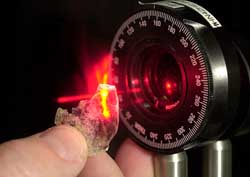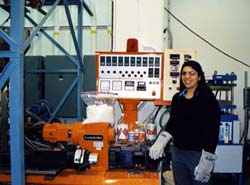
An ultrathin film containing 1-nanometer thick clay particles has been created for the first time, an accomplishment that may yield new materials and devices for medicine, electronics and engineering, according to Purdue University and Belgian scientists.
Using a method that captures clay particles on a crystal, Purdue and Katholieke Universiteit Leuven research partners were able to produce, see and manipulate a single layer of clay. It would take 70,000 of these layers to equal the thickn

In a serendipitous spin-off of HIV/AIDS research, scientists at the National Institute of Allergy and Infectious Diseases (NIAID) and colleagues have found strong evidence that a genetic variation affecting immune system cells protects against heart disease. Details of the work, which also provides further evidence for the role of inflammation in heart disease, will appear in the April 15 issue of the Journal of Clinical Investigation.
“This work demonstrates how NIAID’s commitment to

Plastics are everywhere these days, but current recycling techniques allow only a very limited portion to be reclaimed after initial use. Researchers in the Department of Chemical Engineering at North Carolina State University, working to change that, have developed a unique recycling process for some of the most common kinds of polymers.
The familiar soda bottle is made of a plastic called polyethylene terephthalate (PET). These bottles are ubiquitous, yet recycling them poses challenges, p

Academy Professor Matti Krusius and Antti Finne, M.Sc. (Eng.), were invited to a recent science breakfast, hosted by the Academy of Finland, to talk about their ongoing work to produce a first-ever laboratory simulation of a black hole. A black hole is created as a result of the most extreme concentration of matter.
Scientists have been arguing about the possible existence of black holes for an entire century. Today the existence of black holes is supported by various astrophysical phenomena

EUREKA project LOGCHAIN E-W-LAND-BRIDGE is an ambitious multi-national project to establish an inter-modal inland link as an alternative transport route between the Adriatic Sea and southern Germany to the existing 5,000 km sea journey.
It is envisaged that this link, the “land bridge”, will be an integrated system utilising rail, road and inland waterways such as the Main-Danube canal. This connection will provide essential extensions to the northern European rail and road transport corrido

Scientists are now one step closer to understanding how HIV hides in cells and rears its ugly head once patients stop taking combination drug therapy, which can suppress viral loads to undetectable levels. The phenomenon reflects the existence of hidden populations of latently infected cells. As a result, patients must remain on therapy for life.
Eradication of these cells could lead to a cure for HIV infection. However, researchers have been hampered by their inability to identify them.

– new calculation confirms standard model of particle physics. Contribution of hadronic vacuum polarization determined with unprecedented accuracy. The magnetic moment of the muon is an important precision parameter for…
Technique may prevent formation of unwanted waves that siphon off needed energy. Heating plasma to the ultra-high temperatures needed for fusion reactions requires more than turning the dial on a…

An international team of astronomers, led by researchers from the Astronomical Observatory of the University of Warsaw, have identified a new class of cosmic X-ray sources. The findings have been…

How deubiquitinases USP53 and USP54 cleave long polyubiquitin chains and how the former is linked to liver disease in children. Deubiquitinases (DUBs) are enzymes used by cells to trim protein…

Conceptual blueprint to analyze experimental catalyst data. Machine learning (ML) models have recently become popular in the field of heterogeneous catalyst design. The inherent complexity of the interactions between catalyst…

Antibody that Neutralizes Inhibitory Factors Involved in Nerve Regeneration Leads to Enhanced Motor Function after Acute Spinal Cord Injury. Researchers at 13 clinics in Germany, Switzerland, the Czech Republic and…

How simulations help manufacturing of modern displays. Modern materials must be recyclable and sustainable. Consumer electronics is no exception, with organic light-emitting diodes (OLEDs) taking over modern televisions and portable…

“Neurons that fire together, wire together” describes the neural plasticity seen in human brains, but neurons grown in a dish don’t seem to follow these rules. Neurons that are cultured…

The quest for sustainable energy solutions has been a major focus of scientific research for decades. Solar energy, a clean and renewable source, has emerged as a promising alternative to…

With a processing speed a billion times faster than nature, chip-based laser neuron could help advance AI tasks such as pattern recognition and sequence prediction. Researchers have developed a laser-based…

New technology could remotely identify various types of plastics, offering a valuable tool for future monitoring and analysis of oceanic plastic pollution. Researchers have developed a new hyperspectral Raman imaging…

Artificial Intelligence (AI) has established a strong presence across industries, large and small. The “VoBaKI” research project has empowered small and medium-sized enterprises (SMEs) with an innovative tool to independently…